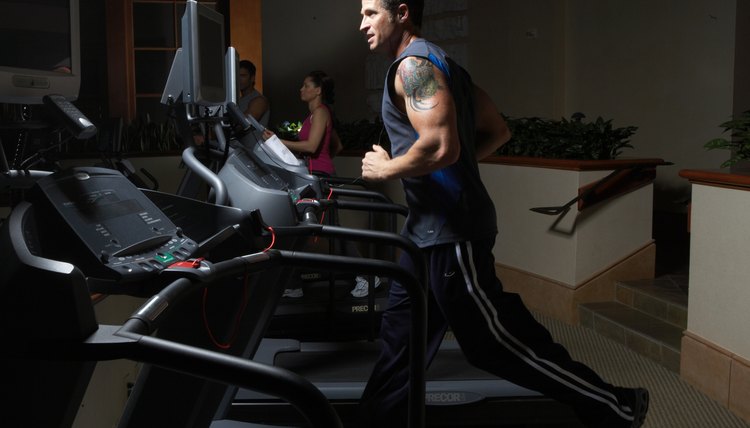The Calories Burned During HIIT on a Treadmill

High-intensity interval training, or HIIT, lets you perform a more vigorous workout and burn plenty of calories in a shorter period of time, relative to workouts in which you maintain about the same intensity throughout your session. HIIT workouts alternate bursts of high-intensity exercise with lower-intensity movements. To perform HIIT on a treadmill, alternate walking or light jogging with brisk jogging or sprints. Check with your physician first, if you’re new to HIIT.
Calories Burned
The variable intensity of an HIIT workout makes it difficult the quantify the number of calories burned. But an HIIT session will burn more calories than a steady-state session of the same duration, and 30 minutes of treadmill running at a steady 6 mph will burn 372 calories, if you weigh 155 pounds. A 2012 study published by the American Physiological Society found that participants who performed just 2.5 minutes of sprint intervals on an exercise bike burned an extra 200 calories throughout the day, including the post-workout recovery period. Treadmill intervals of the same intensity should offer comparable results. A 2007 study confirmed that HIIT’s benefits continue even when you’re finished running. Study participants who did HIIT burned almost 10 percent more calories in the 24 hours after their workouts than a group that performed comparable steady-state sessions.
Fat Burned
Performing HIIT burns more fat than longer, steady-state workouts. In a 2007 study, for example, women who performed a 20-minute HIIT workout lost six times as much body fat as women who did a 40-minute cardio workout at 60 percent of their maximum heart rate. Participants in a 2001 study who performed HIIT for eight weeks lost 2 percent body fat, while participants who did steady-state workouts didn’t lose any fat.
Treadmill HIIT
Even if your treadmill is programmable, you’ll encounter a brief lag when the machine moves from the moderate- to the high-intensity setting. Don’t start timing the high-intensity interval until the treadmill is set to your desired intensity and incline. Use a higher incline during the sprint intervals to strengthen your hamstrings and glutes, then reduce the incline to zero when you slow down.
Sample Treadmill Workouts
Whatever type of workout you perform, warm up first by walking on the treadmill at a moderate pace for five to 10 minutes. If you’re a beginner, try alternating 30 seconds of sprinting with 90 seconds of walking. If you can sustain a fast pace for a longer time, alternate two minutes of hard running with two minutes of walking. You can also gradually increase the intensity of your sprint intervals by raising the incline. Try alternating one-minute sprints and walks. Run the first three sprint intervals with the incline set at level 1, then do the fourth at level 3 and the rest at level 4. Keep the incline at zero when you walk. Try different workouts for 20 to 30 minutes each to see which works best for you. Perform two HIIT workouts per week.
References
- American Council on Exercise: High-Intensity Interval Training
- Harvard Health Publications: Calories Burned in 30 Minutes for People of Three Different Weights
- American Physiological Society: Minutes of Hard Exercise Can Lead to All-Day Calorie Burn
- Simply Shredded: Fit with HIIT: Science is Dropping the Hammer on Endless Bouts of Steady-State Cardio
- Built Lean: Best HIIT Treadmill Workout to Burn Fat
Writer Bio
M.L. Rose has worked as a print and online journalist for more than 20 years. He has contributed to a variety of national and local publications, specializing in sports writing. Rose holds a B.A. in communications.
